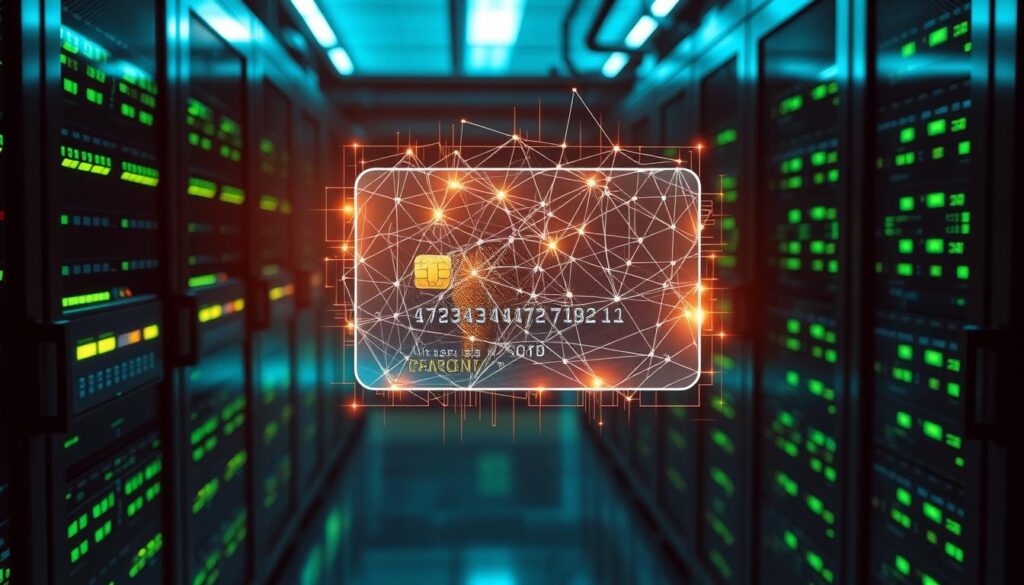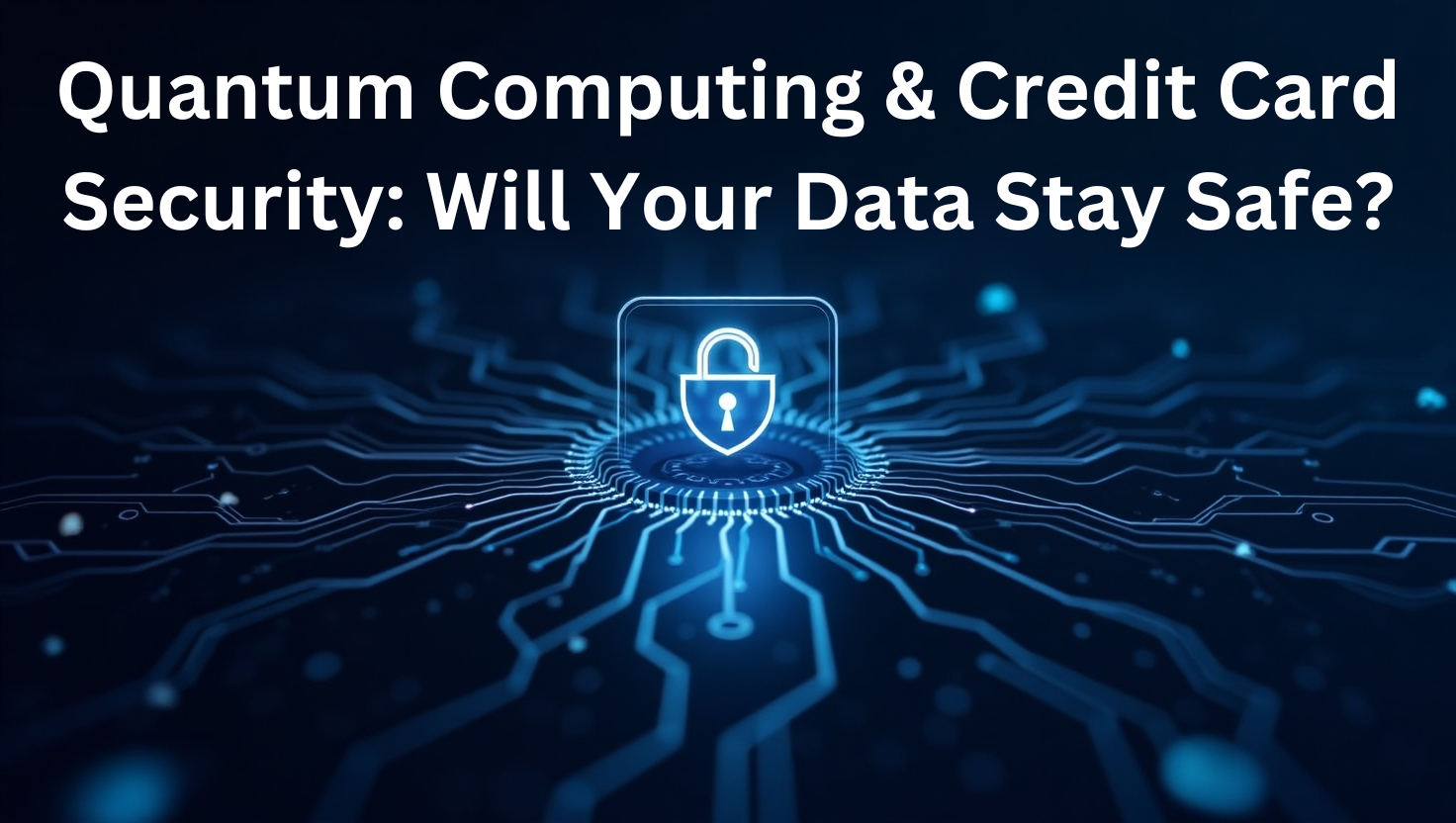
Quantum Computing & Credit Card Security : Quantum computing is becoming more common. It’s important to think about how it might affect credit card security. Quantum computers could break current encryption, putting credit card data at risk.
Today’s credit card security depends on encryption that quantum computers might crack. This makes us wonder about the future of keeping our credit card info safe. We need to find ways to protect our data from quantum computers.
Key Takeaways
- Quantum computing has the potential to break current encryption methods, compromising credit card security.
- Data encryption and cybersecurity measures are crucial to protecting sensitive information.
- Quantum computing and credit card security solutions are necessary to address potential security risks.
- Effective cybersecurity measures can help protect against potential security threats.
- Understanding the potential impact of quantum computing on credit card security is essential for developing effective solutions.
- Implementing quantum-resistant cryptography solutions can help ensure the security of credit card transactions.
- Staying informed about the latest developments in quantum computing and credit card security is crucial for protecting sensitive information.
Understanding the Quantum Computing Revolution
Quantum computing uses quantum mechanics for calculations. It can solve problems that classical computers can’t. This could change how we protect payment security in the future.
Quantum computing is growing fast, with big steps forward lately. Knowing how it works and its uses is key. This knowledge helps us understand its risks and benefits.
What is Quantum Computing?
Quantum computing is based on quantum mechanics. It lets computers handle lots of information at once. This is different from classical computers, which do things one step at a time.
How Quantum Computing Differs from Classical Computing
Quantum computers can work on many things at once. They use superposition and entanglement to do this. But, we need special algorithms to keep our data safe from these computers.
The Timeline of Quantum Development
Quantum computing is getting better fast. Knowing its history and future is important. It will help us keep financial data safe and secure.
Current Credit Card Security Measures
It’s important to know how credit cards are secured today, especially with new threats from quantum computers. Credit cards use encryption, tokenization, and SSL protocols to keep your financial info safe. But, these methods might not work well against quantum computers.
Here are some main ways credit cards are secured:
- Encryption: This makes sensitive info unreadable to stop hackers.
- Tokenization: It swaps real data with tokens, making it hard for hackers to find the real info.
- Secure Sockets Layer (SSL) protocols: These create a safe link between your browser and the server, protecting your data while it’s being sent.
Even though these steps help keep credit cards safe, they might not be enough against quantum computers. We need stronger security to keep our financial data and online transactions safe.
Financial data protection is key to keeping credit cards secure. We must keep improving our security to fight off new threats. By knowing what’s not working, we can find better ways to protect our sensitive info from quantum computers.
Learn more about the fundamentals of quantum computing and its potential impact on cybersecurity from experts at IBM Quantum.
The Quantum Threat to Traditional Encryption
Quantum computing brings new risks, especially for traditional encryption. This technology could break current encryption methods. This could put the security of credit card transactions at risk.
The timeline for these risks is unclear. But, we must prepare for the worst. Cybersecurity measures are key to fighting these risks. We need new encryption methods that can resist quantum attacks.
Breaking Current Encryption Methods
Quantum computers are much faster than classical ones. This makes them a big threat to traditional encryption. They can break current encryption, putting sensitive data at risk.
To fight this, we need new encryption methods. Lattice-based and code-based cryptography are examples. These methods are designed to be safe from quantum attacks.
Timeline of Potential Security Risks
The timeline for these risks is uncertain. But, we must be ready for the worst. Here are some risks we might face:
- Short-term risks: Quantum computers can break current encryption methods, compromising the security of credit card transactions and other sensitive data.
- Long-term risks: Developing new, quantum-resistant encryption methods may take time, leaving sensitive data vulnerable to quantum attacks.
Vulnerable Security Systems
Some security systems are more at risk from the quantum threat:
| Security System | Vulnerability |
|---|---|
| RSA | Quantum computers can factor large numbers, breaking RSA encryption. |
| Elliptic Curve Cryptography | Quantum computers can solve the elliptic curve discrete logarithm problem, breaking elliptic curve cryptography. |
In conclusion, the quantum threat to traditional encryption is a big concern. We need new, quantum-resistant encryption methods to keep data safe. By understanding the risks and taking cybersecurity steps, we can protect sensitive data.
Quantum Computing & Credit Card Security: Will Your Data Stay Safe?
Exploring the effect of quantum computing on credit card security is crucial. We must think about how to keep sensitive info safe. The future of payment security depends on protecting data from quantum threats.
Data privacy in finance is a big worry, especially with quantum computing coming. To fight these risks, banks need to use quantum-resistant cryptography. This will keep credit card transactions safe.
Here are some ways to keep credit cards secure in the quantum age:
- Use quantum-resistant encryption algorithms
- Boost data privacy in finance
- Develop secure quantum key distribution methods
The future of payment security is tied to quantum computing and credit card safety. By focusing on data privacy and using quantum-resistant solutions, we can keep payments safe and reliable.
| Security Measure | Description |
|---|---|
| Quantum-Resistant Encryption | Encryption methods designed to withstand quantum computer attacks |
| Quantum Key Distribution | A method of secure key exchange using quantum mechanics |
| Data Privacy Measures | Strategies to protect sensitive financial data from unauthorized access |
Quantum-Resistant Cryptography Solutions
The threat of quantum computing attacks is real. We need to protect our sensitive data with quantum-resistant cryptography. This includes post-quantum cryptography and quantum key distribution. They offer strong security against quantum attacks.
Some key features of quantum-resistant cryptography solutions include:
- Enhanced security protocols to prevent quantum computing attacks
- Post-quantum cryptography methods, such as lattice-based cryptography and code-based cryptography
- Quantum key distribution techniques, like quantum entanglement-based cryptography
It’s tough to implement these solutions, but it’s vital to stay ahead of security risks. Quantum key distribution is a promising method. It allows for secure key exchange over long distances. By investing in quantum-resistant cryptography, we can keep our data safe in a post-quantum world.
Experts suggest a multi-faceted approach to quantum-resistant cryptography. They recommend combining post-quantum cryptography and quantum key distribution for strong security. By adopting these solutions, we can safeguard our data from quantum computing threats and ensure a secure future.
| Cryptography Method | Security Level | Implementation Challenges |
|---|---|---|
| Post-Quantum Cryptography | High | Complexity of implementation |
| Quantum Key Distribution | High | Distance limitations and infrastructure requirements |
Financial Institutions’ Preparation for the Quantum Era

As we move into the quantum era, financial institutions are getting ready for the risks of quantum computing. Cybersecurity measures are being improved to fight off quantum attacks. These attacks could harm the safety of important data.
Financial groups are putting money into quantum-safe cryptography. They’re working on new security plans and teaming up with others to share knowledge. Some important actions include:
- Using quantum-safe encryption methods
- Creating new security plans to fight quantum attacks
- Working together to share info and best practices
By doing these things, financial institutions can get ready for the quantum era. They can keep their customers’ data safe.
The quantum era brings both chances and challenges for financial groups. By investing in quantum-safe cryptography and making new security plans, they can stay ahead. They can also protect their customers’ sensitive data.
Consumer Impact and Protection Strategies
As quantum computing grows, it’s key for people to know how it affects their data. The danger of quantum computers breaking current encryption is real. This shows we need strong data protection steps.
To keep your data safe, start by using strong passwords and two-factor authentication. For the long haul, consider quantum-resistant cryptography. Also, keep up with the latest security news.
Here are some ways to protect your data:
- Use unique and complex passwords for all accounts
- Enable two-factor authentication whenever you can
- Keep your software and operating systems updated
- Be careful when sharing personal info online
By following these tips, you can lower the risk of data breaches. It’s also vital to stay updated on quantum computing and data protection. This way, you can make smart choices about your personal data.
| Strategy | Description |
|---|---|
| Strong Passwords | Use unique and complex passwords for all accounts |
| Two-Factor Authentication | Enable two-factor authentication whenever possible |
| Regular Updates | Regularly update your software and operating systems |
The Role of Government Regulations
As technology advances, government regulations are key in keeping us safe. They help protect us from security risks, especially with quantum computing. Governments are updating laws to include proposed security standards for quantum computing.
Government regulations are vital. They set rules to keep our financial data safe. The legislative framework is being updated to include proposed security standards for quantum computing.
Some key steps governments are taking include:
- Updating laws to include quantum computing security standards
- Creating new agencies to oversee quantum computing security
- Supporting research for quantum-resistant cryptography
Together, governments, banks, and consumers can keep credit card security strong. The government regulations and proposed security standards are crucial. They help stop quantum computing attacks and keep our data safe.
The future of credit card security relies on good legislative framework and proposed security standards. Governments must act fast to regulate quantum computing. This way, they can prevent security threats and protect us.
| Initiative | Description |
|---|---|
| Quantum Computing Security Standards | Creating standards for quantum-resistant cryptography |
| Legislative Framework Updates | Updating laws to include quantum computing security standards |
| Research and Development Funding | Supporting research for quantum-resistant cryptography |
Emerging Technologies in Payment Security
Payment security is changing fast, thanks to emerging technologies. Blockchain is a big player, offering strong security against quantum threats. Artificial intelligence also helps by spotting and stopping fraud, making payment security better.
These emerging technologies are set to change the game in payment security. They bring many benefits, like:
- Enhanced security features
- Improved transaction speed
- Increased customer trust
Experts say the key to success is investing in research and development. This way, we can keep payment security strong and ready for quantum technology impact.
In conclusion, the future of payment security is bright with emerging technologies. As we face the challenges of quantum computing, keeping payment security a top priority is crucial.
| Technology | Benefits | Risks |
|---|---|---|
| Blockchain | Robust security, transparency | Scalability issues |
| Artificial Intelligence | Enhanced security features, improved transaction speed | Dependence on data quality |
Timeline for Implementation of Quantum-Safe Solutions

Creating a timeline for quantum-safe solutions is key to fight quantum computing attacks. It’s about making a long-term security roadmap. This roadmap outlines steps to keep sensitive data safe.
Investing in quantum-resistant cryptography solutions is a big part of this plan. This means developing new security methods and using existing ones. It helps make sure data stays safe from quantum threats.
Short-term steps include:
- Checking current security systems for weak spots
- Creating a plan for using quantum-safe solutions
- Teaching employees about quantum computing security
By sticking to this timeline and making a detailed long-term security roadmap, companies can get ready for quantum risks. They can then use quantum-safe solutions well.
| Short-term Preparations | Long-term Security Roadmap |
|---|---|
| Assess current security systems | Invest in quantum-resistant cryptography solutions |
| Develop a plan for implementation | Implement new security protocols |
| Invest in employee education and training | Continuously monitor and update security systems |
Discover Credit Card Apps : Can making debt a game help pay off credit card balances? Financial technology has led to new ways to manage debt. Credit card companies and app developers have created apps that use game design to motivate users. These apps help people develop better financial habits and reach their debt goals. read more about it from here – Discover Credit Card Apps That Gamify Debt Repayment
Quantum Computing & Credit Card Security : Conclusion
Quantum computing is changing fast, and it’s a big threat to how we keep credit card info safe. This could really hurt the financial world and how we protect our data. But, if we work together, we can find new ways to keep our digital payments safe.
We need to start getting ready now, even though we don’t know exactly when quantum computers will be strong enough to break current codes. We should invest in new cryptography, use quantum key distribution, and set strong security rules. By working together and spreading the word, we can keep our financial systems safe and protect our data.
The battle to keep up with quantum computing is on. With hard work, new ideas, and a united effort, we can face the future with confidence. We’re ready to tackle the challenges and seize the chances that quantum computing brings.
Quantum Computing & Credit Card Security : FAQ
What is quantum computing, and how does it differ from classical computing?
Quantum computing uses quantum mechanics for calculations. It’s different from classical computing because it can solve problems that classical computers can’t. This includes breaking encryption methods.
How does quantum computing pose a threat to traditional credit card security measures?
Quantum computers can break encryption faster than classical computers. This makes credit card transactions less secure. It’s a big problem because it can crack codes that were thought to be safe.
What are the current credit card security measures, and how effective are they against quantum computing attacks?
Today, credit cards use encryption, tokenization, and SSL protocols for security. But, these might not stop quantum computing attacks. Quantum computers can break these encryption methods.
What are the quantum-resistant cryptography solutions that can be used to protect against quantum computing attacks?
Solutions like post-quantum cryptography and quantum key distribution can protect against quantum attacks. They use new encryption methods that quantum computers can’t break.
What steps can consumers take to protect their data in the face of the quantum computing threat?
Consumers can use strong passwords and two-factor authentication to protect their data. They should also stay updated on security threats. Using quantum-resistant cryptography is a good long-term strategy.
What is the role of government regulations in protecting against quantum computing attacks?
Governments are making rules to use quantum computing safely. They’re proposing new standards and updating laws. It’s important for everyone to work together to stay safe from quantum threats.
What is the timeline for the implementation of quantum-safe solutions, and what should be included in a long-term security roadmap?
The timeline for quantum-safe solutions is unclear, but we should prepare for the worst. A good security plan includes investing in new cryptography and developing new protocols. It also means getting ready to defend against quantum attacks now.








1 thought on “Quantum Computing & Credit Card Security: Will Your Data Stay Safe?”